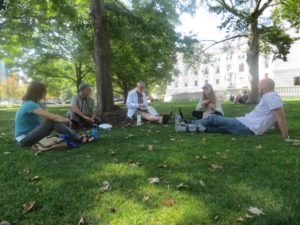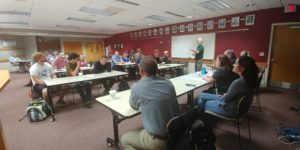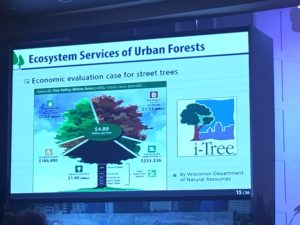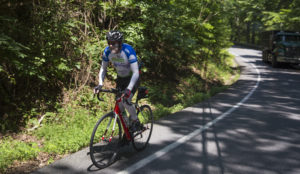 The Urban Forestry team hosted Valerie McClannahan from the Minnesota DNR on September 25th and 26th. Valerie was particularly interested in our Urban Forest Assessment program, the urban wood industry in Wisconsin, and general programmatic items. During her visit, we highlighted the Wisconsin Community Tree Map and the Capital Park inventory, our UFIA program, our canopy assessment project, and the urban homeowner survey. She is interested in how Minnesota can leverage some of their existing work and incorporate some of the additional pieces we are developing for statewide assessments. Continue reading “Minnesota DNR Urban Forestry visits Wisconsin”
The Urban Forestry team hosted Valerie McClannahan from the Minnesota DNR on September 25th and 26th. Valerie was particularly interested in our Urban Forest Assessment program, the urban wood industry in Wisconsin, and general programmatic items. During her visit, we highlighted the Wisconsin Community Tree Map and the Capital Park inventory, our UFIA program, our canopy assessment project, and the urban homeowner survey. She is interested in how Minnesota can leverage some of their existing work and incorporate some of the additional pieces we are developing for statewide assessments. Continue reading “Minnesota DNR Urban Forestry visits Wisconsin”
Urban Forestry News
UW Forestry students visit DNR
 On Wednesday, October 4th UW-Madison students from the Forestry program visited the DNR. About 16 students attended an informational session on the Division of Forestry which highlighted a few of our programs. Continue reading “UW Forestry students visit DNR”
On Wednesday, October 4th UW-Madison students from the Forestry program visited the DNR. About 16 students attended an informational session on the Division of Forestry which highlighted a few of our programs. Continue reading “UW Forestry students visit DNR”
Wisconsin efforts highlighted across the world
 On September 13th, the 2nd ‘Asia Pacific Urban Forestry Meeting’ was held in Seoul, South Korea. Asia is home to a large urban population that continues to grow, almost depleting many natural resources. This meeting was hosted to share industry knowledge on how well-managed forests and urban green spaces can help relieve many of the socio-economical stresses while creating a more sustainable and resilient urban environment. This year’s meeting was focused on developing an Action Plan to “guide countries toward the sound implementation of urban forestry in the region.”
On September 13th, the 2nd ‘Asia Pacific Urban Forestry Meeting’ was held in Seoul, South Korea. Asia is home to a large urban population that continues to grow, almost depleting many natural resources. This meeting was hosted to share industry knowledge on how well-managed forests and urban green spaces can help relieve many of the socio-economical stresses while creating a more sustainable and resilient urban environment. This year’s meeting was focused on developing an Action Plan to “guide countries toward the sound implementation of urban forestry in the region.”
Continue reading “Wisconsin efforts highlighted across the world”
UW-Extension and other trainings available
UW-Extension will be hosting fall workshops on tree pruning. This is a one-day workshop will show parks and tree professionals how to properly prune trees, from new tree training to mature tree maintenance, to create a strong enduring structure, maintain vigor, and achieve specific municipal objectives. The workshop will include classroom instruction on pruning fundamentals and outdoor, hands-on demonstration of personal protective equipment along with pruning methods and techniques. These workshops are being help in various locations: Oshkosh, Waukesha, Kenosha, Stevens Point, Eau Claire and Madison. Information about these events and other urban events is posted on the Urban Forestry training and events webpage.
For more information contact Ellen Clark (EllenA.Clark@Wisconsin.gov), Urban Forestry Communication Specialist, at 608-267-2774.
Capitalizing on the Wisconsin Community Tree Map
The Wisconsin Community Tree Map is an accessible database of tree inventories compiled into an interactive and easy to use map based program, to encourage and engage awareness of the composition and benefits of urban trees. Continue reading “Capitalizing on the Wisconsin Community Tree Map”
Urban Forestry Council awards
Each year, city tree champions from throughout Wisconsin are recognized for outstanding community service
The Wisconsin Urban Forestry Council invites citizens to nominate local individuals and organizations to be recognized for their efforts to protect, preserve and increase the number of trees that line city streets, fill community parks and beautify neighborhoods throughout the state.
Wisconsin Urban Forestry Council announces new members
The Wisconsin Urban Forestry Council is pleased to announce the addition of four new members to the group. We are especially pleased to have increased our geographic and professional diversity and look forward to working with them on issues related to Wisconsin’s urban and community forests. Continue reading “Wisconsin Urban Forestry Council announces new members”
Tour de Trees was a success

Dick Rideout riding his bike for the cause.
Tour des Trees is an annual bike ride, hosted by STIHL to benefit TREE fund. Continue reading “Tour de Trees was a success”
Wisconsin Arborist Association Summer Conference
 Hundreds of people from the arboriculture industry descended upon the Lussier Family Heritage Center in Madison this August for the Wisconsin Arborist Association’s (WAA) annual summer conference. Continue reading “Wisconsin Arborist Association Summer Conference”
Hundreds of people from the arboriculture industry descended upon the Lussier Family Heritage Center in Madison this August for the Wisconsin Arborist Association’s (WAA) annual summer conference. Continue reading “Wisconsin Arborist Association Summer Conference”
Urban Forestry grant reminder
A reminder that the application deadline is coming up for 2018 Urban Forestry Grants! Continue reading “Urban Forestry grant reminder”
